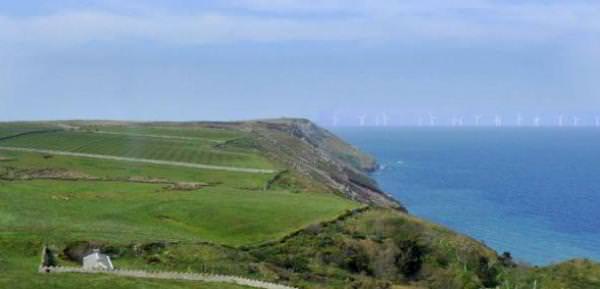"On one of those impossibly lovely summer days I had a personal epiphany, sitting in my jeans on the thrift-scattered northern tip of Lundy. Beyond the precipitous rocks, my wellies clipping the tumbling edge, was, well nothing. I say nothing, but I mean, really, something vast, eternal and profoundly beautiful. At the base of the cliff the sea hurled itself against Lundy’s jagged flank with terrifying force, the screeching kittiwakes and shags soared and scores of puffins looked calmly out from their tiny ledges. In the swirling waters seals bobbed and basked, and unbroken expanses of blue sea and blue sky reached away to finally meet in the thin green line of south Wales. Apart from one low Victorian lighthouse nothing in that scene had changed for thousands of years, since Caesar’s galleons sailed north to claim Britannia or St Paul saw a vision on his journey to Damascus. As I laboured back up the rocky path, it was with growing certainty that, whatever the odds, we had to oppose the scheme to erect the largest wind farm in the world in these waters.
Until that day, I have to admit, I was undecided. We need renewable energy, I thought, and we at the Landmark Trust have been at the forefront of using it in historic building – installing air source heat pumps, PV cells and biomass boilers. I spend my weekends in Norfolk, and the great turbines on and off shore have never worried me, standing in a long tradition of buildings that harvest the wind in a landscape largely formed by man and machine. Wouldn’t it be small-minded to speak out against the ‘Atlantic Array’?
And yet. And yet. It just cannot follow that to embrace the importance of low carbon energy is to forfeit the ability to say that some developments are not right for some locations. No-one is proposing a vast wind farm on Salisbury Plain or in Windsor Great Park. It must be that we can believe in the importance of renewable energy and also believe that not everywhere is suitable.
A mega-wind farm in the Bristol Channel for instance. Less than nine miles from Lundy, the proposed development would come three miles closer to land than the Government itself recommends. Though Lundy has only 28 permanent residents, almost 5,000 people stay here every year and 15,000 visit more visit, all drawn by its wild beauty. Most, like the medieval hermits who preceded them, seek escape, which they find on a three-mile chunk of granite with no roads, pavements or streetlights.
As I weaved my way to my little house (a former pigsty) by torchlight that night, the black skies sparkling with infinite stars, I felt certain of the terrible loss Lundy would suffer should the ‘Atlantic Array’ go ahead. Its 240 turbines (most offshore wind farms have fewer than 80), each one roughly the height of the Canary Wharf Tower would be spread out across an area as large as Bristol. The enormous red lights surmounting the turbines would flash day and night, their discordant neon winking creating an industrial, sci-fi landscape. After years of the noise and massive reverberation as each 220 metre turbine was pile-driven into the sea bed would the porpoises still play and the guillemots still swoop? No-one knows. But when Becky, our Warden, told me over breakfast that the building of one 17-metre high lighthouse in 1899 drove away Lundy’s entire gannet population never to return, I felt it our absolute responsibility not to leave it to chance."
Anna Keay

An artist's impression of the wind farm from Lundy